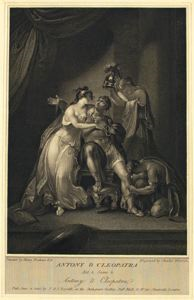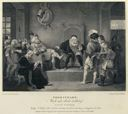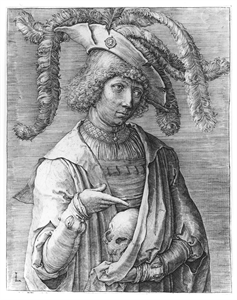
John Boydell
English, 1719–1804
Josiah Boydell (aka Joshua Boydell)
English, 1752–1817
Charles Warren (aka Charles Turner Warren)
English, 1762–1823
after Henry Tresham
Irish, about 1751–1814
From Boydell's Graphic Illustrations of the Dramatic Works of Shakespeare
In 1786, a successful London publisher, alderman John Boydell, conceived of a gallery of art devoted to scenes from Shakespeare’s plays. Named for its founder, the Boydell Shakespeare Gallery was one of the first large-scale commercial endeavors intended to promote British literature and artists both in Great Britain as well as throughout the European continent. He commissioned over 167 paintings of scenes from Shakespeare’s plays and produced engravings based on these paintings. In creating the engravings, John Boydell partnered with his son, Josiah, whose name appears after his father’s in the list above. The third name is that of the engraver, and the fourth is that of the painter who created the original composition in oils. The role of the engraver was to transfer the painter’s composition onto plates for printing.
About this scene:
Shakespeare pursues the potent combination of political ambition and sexual passion to ancient Rome where general Marc Antony rules one-third of the empire but not his political or sexual partners, for young Octavius Caesar schemes to achieve one-man rule while the Egyptian queen Cleopatra beguiles Antony‘s loyalty. As their efforts intensify, Antony tries to maintain his alliances and honor but begins to lose both.
After a major loss, strategic blunders, and Caesar’s efforts to co-opt Cleopatra, Antony calls his significantly-named servant, “Eros! Mine armor, Eros!” and again readies for battle [seen here, without armor] as Cleopatra tries to help. But losses mount, Antony feels betrayed, and when fearful Cleopatra sends false report of her death, he despairs and commits suicide, dying in her arms. Alone before the insurmountable forces of Rome, Cleopatra also commits suicide, hoping to re-join her Antony, leaving Caesar emperor. The world well lost for love?
-Susan Willis, dramaturg, Alabama Shakespeare Festival, September 28, 2020
English, 1719–1804
Josiah Boydell (aka Joshua Boydell)
English, 1752–1817
Charles Warren (aka Charles Turner Warren)
English, 1762–1823
after Henry Tresham
Irish, about 1751–1814
Antony and Cleopatra, Act 4, Scene 4
about 1804From Boydell's Graphic Illustrations of the Dramatic Works of Shakespeare
Object Type:
Print
Dimensions:
10 1/2 x 6 5/8 in. (27 x 17 cm)
Medium and Support:
Engraving on paper
Accession Number:
2016.0008.0015
Credit Line:
Gift of Dr. and Mrs. Frederick S. Wolf, by exchange, and Montgomery Museum of Fine Arts Association Purchase
In 1786, a successful London publisher, alderman John Boydell, conceived of a gallery of art devoted to scenes from Shakespeare’s plays. Named for its founder, the Boydell Shakespeare Gallery was one of the first large-scale commercial endeavors intended to promote British literature and artists both in Great Britain as well as throughout the European continent. He commissioned over 167 paintings of scenes from Shakespeare’s plays and produced engravings based on these paintings. In creating the engravings, John Boydell partnered with his son, Josiah, whose name appears after his father’s in the list above. The third name is that of the engraver, and the fourth is that of the painter who created the original composition in oils. The role of the engraver was to transfer the painter’s composition onto plates for printing.
About this scene:
Shakespeare pursues the potent combination of political ambition and sexual passion to ancient Rome where general Marc Antony rules one-third of the empire but not his political or sexual partners, for young Octavius Caesar schemes to achieve one-man rule while the Egyptian queen Cleopatra beguiles Antony‘s loyalty. As their efforts intensify, Antony tries to maintain his alliances and honor but begins to lose both.
After a major loss, strategic blunders, and Caesar’s efforts to co-opt Cleopatra, Antony calls his significantly-named servant, “Eros! Mine armor, Eros!” and again readies for battle [seen here, without armor] as Cleopatra tries to help. But losses mount, Antony feels betrayed, and when fearful Cleopatra sends false report of her death, he despairs and commits suicide, dying in her arms. Alone before the insurmountable forces of Rome, Cleopatra also commits suicide, hoping to re-join her Antony, leaving Caesar emperor. The world well lost for love?
-Susan Willis, dramaturg, Alabama Shakespeare Festival, September 28, 2020
Keywords
Click a term to view the records with the same keyword
Related Objects
Click a record to view

Tempest, Act 1, Scene 2
2016.0008.0001

Merry Wives of Windsor, Act 5, Scene 5
2016.0008.0002

Much Ado About Nothing, Act 4, Scene 2
2016.0008.0003

Midsummer-Night’s Dream, Act 2, Scene 1
2016.0008.0004

Merchant of Venice, Act 3, Scene 2
2016.0008.0005

Taming of the Shrew, Act 4, Scene 5
2016.0008.0006

Twelfth Night, Act 2, Scene 3
2016.0008.0007

Macbeth, Act 1, Scene 3
2016.0008.0008

Macbeth, Act 5, Scene 1
2016.0008.0009

King Richard II, Act 3, Scene 2
2016.0008.0010

King Henry IV, Part 1, Act 2, Scene 1
2016.0008.0011

King Henry V, Act 3, Scene 3
2016.0008.0012

King Henry VI, Part 1, Act 5, Scene 4
2016.0008.0013

King Richard III, Act 3, Scene 1
2016.0008.0014

Romeo and Juliet, Act 3, Scene 5
2016.0009.0001

Hamlet, Act 3, Scene 4
2016.0009.0002

Hamlet, Act 4, Scene 7
2016.0009.0003
Portfolio List
Click a portfolio name to view all the objects in that portfolio
This object is a member of the following portfolios:
Your current search criteria is: All Object records and [Object]Century is "Nineteenth century".

 by Artist (109)
by Artist (109)
